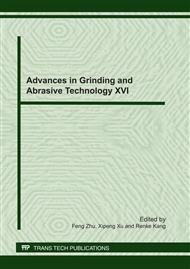p.1
p.6
p.11
p.16
p.24
p.29
p.34
p.39
p.44
Investigation on the Workpiece Surface Residual Stress in High Efficiency Deep Grinding with Ultra High Wheel Speeds
Abstract:
The residual stress on the ground surface of workpiece in high efficiency deep grinding (HEDG) has been investigated. It has been found that the mechanism in forming the ground surface residual stress in HEDG is much different to that in the conventional shallow cut grinding process. It is not a thermally dominant event as in most of the shallow cut grinding mode; it is instead driven by the combined effects of both the thermal and mechanical loadings. The compressive plastic deformation near the workpiece surface during grinding and the short contact time in the HEDG regime, makes it possible to generate compressive surface stresses even when the surface temperatures are above 700-800°C.
Info:
Periodical:
Pages:
24-28
Citation:
Online since:
July 2011
Authors:
Keywords:
Price:
Сopyright:
© 2011 Trans Tech Publications Ltd. All Rights Reserved
Share:
Citation:


